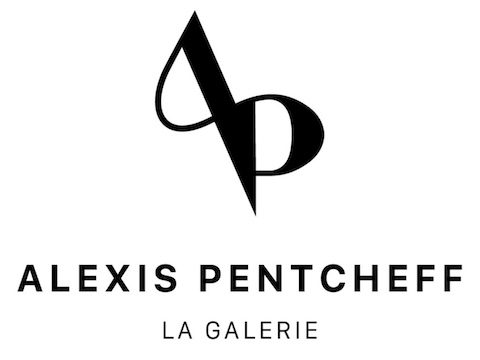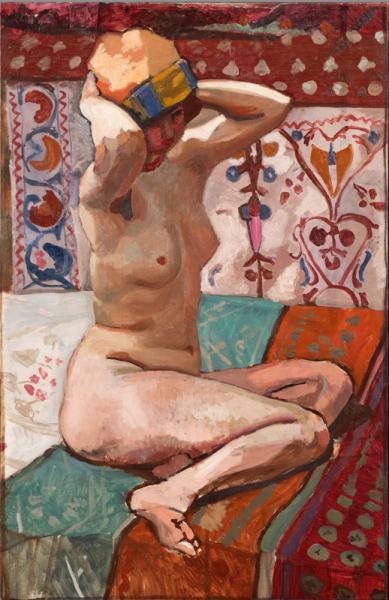Nu au turban jaune, circa 1911
Oil on canvas, stamped lower left.
146 x 97 cm
Provenance :
Artist's family
Galerie Najuma, Marseille
Galerie Alexis Pentcheff, Marseille
Private collection, France
Exhibitions :
Alfred Lombard, Redécouverte, Galerie Alexis Pentcheff, Marseille, November 22 - December 20, 2014, reproduced in the exhibition catalog under no. 4, p.16.
Alfred Lombard, Couleur et Intimité, Musée Regards de Provence, Marseille, March 13 - August 23, 2015, reproduced in the exhibition catalog on p.9 and 52.
Bibliography:
Giulia Pentcheff, Alfred Lombard, Galerie Alexis Pentcheff, Marseille, 2019, reproduced p.58 and as n°53 on p.179.
CORPS SUR DÉCOR
The most Fauve of our Marseilles artists, Alfred Lombard, is also undoubtedly one of the least known. Yet his life and work are fascinating. A major figure of modernity in Provence, a theorist of mural painting, Lombard is one of the artists the gallery has always ardently defended, even devoting a monograph to him, published in 2019.
Born into the union of two families typical of the Marseilles business bourgeoisie of the Third Republic, the uncompromising and courageous young man had strongly resisted his father's injunctions to embrace the painting career that called him, encouraged in this path by a couple of poet friends, who would have been the benevolent and formative big brother and big sister, the pillars of his artistic education, Joachim and Marie Gasquet. At their Fontlaure estate in Eguilles, he saw his first paintings by Cézanne, drank from albums of reproductions brought back from Siena, fed on those poetic evenings when Joachim's voice carried the vibrant hopes of an entire generation, encountered a communion of thought and finally found what he had missed so much in the shelter of this almost familial cocoon of artistic emulation and encouragement.
Buoyed by this climate of approval and admiration for his work, he dared to send his first paintings to Paris. He was admitted to the Salon d'Automne in 1905, the year of the Fauve explosion, without even having attended the Ecole des Beaux-Arts, having preferred the lively companionship of the studio with Marseille painter Alphonse Moutte to teaching that he considered too academic and outdated.
Along with the Gasquet family and others, such as his friend Pierre Girieud, Lombard had the crazy idea of creating a structure in Marseille that would champion young painting. At the time, the provinces were poorly served in this area, and while young painters could show their work in the capital, the regions were excluded from this type of event.
Under the impetus of enlightened minds, a number of initiatives such as the Cercle de l'art moderne in Le Havre, and the Salons de Mai in Marseille, proposed to remedy this situation in their own way.
Preceded by the Salon de Provence in 1907, two editions of these Salons de Mai were held in 1912 and 1913, but their prospects were quickly dashed by the imminence of world conflict.
Lombard had nevertheless tried to open a breach in his native city, to pave the way for modern art from a multidisciplinary perspective, welcoming painting, sculpture, music and poetry, all of which were very much alive and kicking in the Phocaean city.
This large, exuberantly decorative Nude dates from the period before the First World War, a time of youthful daring.
From 1910 onwards, Lombard, like the others, deserted the lands that Fauvism had exhausted by its violence, to take refuge in a more nuanced interpretation, exploring the decorative vein.
In 1910, a major manifesto painting entitled La Terrasse sur le Vieux-Port de Marseille (now at the Musée d'Art Moderne in Le Havre) had initiated this shift, from the biting acidity of a Derain or Vlaminck that he had been able to bring to Le Vallon des Auffes (now at the Musée des Beaux-Arts in Marseille) to a more balanced composition and palette.
Gradually, his research, particularly in fresco and mural painting, led him towards a "classical modernity", aided by his immense culture, in reaction to the growing trend towards abstraction. Lombard took refuge in the Latin tradition of his origins, attempting to reinterpret his Mediterranean heritage in the light of modern-day experience.
He produced little, theorized a lot, reflected on his art, refused to make any compromise and even, after a notable personal exhibition at Rosenberg in 1914, then at Druet in 1925, refused to exhibit his work, to submit it to any bargaining; an ideal that he can support because of his privileged condition since his fortune, of family origin, shelters him from the unbearable constraint of having to earn his daily bread, which torments other painters like his friend Girieud (despite the financial assistance that Lombard often gave him). But at the time of our painting, Lombard is not yet the solitary painter who patiently constructs his canvases, sometimes monumental, studying minute cut-outs, in the light of the glass roof of the great modernist workshop in Boulogne that the architect Pierre Patout imagined for him. He is still a young man, tempted by the decorative exuberances which also haunted his elder Matisse, at approximately the same time. The naked body, surrounded - heritage of the Fauves, stands out against a background completely saturated with fabrics with different patterns, a visual accumulation undoubtedly intended to highlight the nudity of the model, the power of this body, made of a monochrome of ochres and pinks interspersed with greens in places. The model is present without being classic, vibrating through the touch, the violent shadows echoing the circle through which this body truly lives on the canvas.
Heir to the Fauves and modern in his own way, Lombard valued his southern heritage, which he exploited over time in his painting of different kinds. This nude was produced during a pivotal period in his career and testifies to a shift in orientation on the part of the artist, who embarked on a new path in the early 1910s, after the excesses inspired by Fauvism. Soon, Lombard will experience frescoing (from 1912) and from this practice, his easel painting will be transformed.

